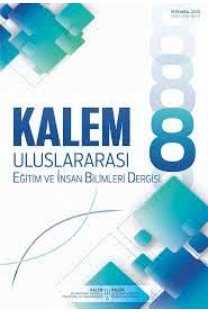DIR/Floortime: Otizm Spektrum Bozukluğunda Bir Erken Müdahale Modeli
DIR/Floortime: An Early Intervention Model in Autism Spectrum Disorders
___
- APA. (2013). Diagnostic ans statistical manual of mental disorders-DSM-5. Washington: American Psychiatric Publishing.
- Binns, A. V. ve Oram-Cardy, J. (2019). Developmental social pragmatic interventions for preschoolers with autism spectrum disorder: A systematic review. Autism & Developmental Language Impairments Volume, 4(1), 1-18.
- Carpente, J. A. (2016). Investigating the effectiveness of a developmental, individual difference, relationship-based (DIR) improvisational music therapy program on social communication for children with autism spectrum disorder. Music Therapy Perspectives, 35(2), 160-174.
- Casenhiser, D. M., Shanker, S. ve Stieben, J. (2013). Learning through interaction in children with autism: Preliminary data from a social-communication-based intervention. Autism, 17(2), 220-241.
- Davies, L. N. (2016). An evaluation of the use of a DIR/Floortime intervention model in a specialist school setting. Yayımlanmamış doktora tezi, Cardiff University Enstitute. http://orca.cf.ac.uk/95849/1/FinalSubmissionThesis-c1057756%20%281%29 %20with%20amendments%203.pdf
- Dionne, M. ve Martini, R. (2011). Floor time play with a child with autism: a single-subject study. Canadian Journal of Occupational Therapy, 78(3), 196-203.
- Greenspan, S. I. (1992). Reconsidering the diagnosis and treatment of very young children with autistic spectrum or pervasive developmental disorder. Zero to Three, 13(2), 1-9.
- Greenspan, S. I. ve Wieder, S. (2005). Can children with autism master the core deficits and become empathetic, creative and reflective? The Journal of Developmental and Learning Disorders, 9, 39-61.
- Greenspan, S. I. ve Wieder, S. (1997). Developmental patterns and outcomes in infants and children with disorders in relating and communicating: A chart review of 200 cases of children with autistic spectrum diagnoses. The Journal of Developmental and Learning Disorders, 1(1), 87-141.
- Greenspan, S. I. ve Wieder, S. (1998). The child with special needs: Intellectual and emotional growth. Reading, MA: Addison Wesley.
- Greenspan, S. I. ve Wieder, S. (2005). Can children with autism master the core deficits and become empathetic, creative and reflective? A ten to fifteen year follow-up of a subgroup of children with autism spectrum disorders (asd) who received a comprehensive Developmental, Individual-difference, Relationship-based (DIR) Approach. The Journal of Developmental and Learning Disorders, 9, 39-61.
- Greenspan, S. I. ve Wieder, S. (2006). Engaging autism: Using the Floortime Approach to help children relate, think and communicate. Cambridge, Ma: Da Capo Press.
- Greenspan, S. I., Wieder, S. ve Simons, R. (1998). The child with special needs: Encouraging intellectual and emotional growth. Reading, MA: Addison Wesley.
- Hess, E. B. (2013). DIR Floortime DIR®/Floortime™: Evidence based practice towards the treatment of autism and sensory processing disorder in children and adolescents. International Journal of Child Health and Human Development, 6(3), 267-274.
- Horn, S. E. (2011). DIR/Floortime model: Using relationship-based intervention to increase social-emotional functioning in children with autism. Research Papers. Paper 67. http://opensiuc.lib.siu.edu/gs_rp/67
- Ingersoll, B. R. (2010). Teaching social communication: A comparison of naturalistic behavioral and development, social pragmatic approaches for children with autism spectrum disorders. Journal of Positive Behavior Interventions, 12(1), 33-43.
- Lal, R. ve Chhabria, R. (2013). Early intervention of autism: A case for Floor Time Approach (chapter 29). In M. Fitzgerald (Ed), Recent advances in autism spectrum disorders-Volume I (pp. 691-717). INTECH Open Access Publisher. ISBN 978-953-51-1021-7.
- Liao, S. T., Hwang, Y. S., Chen, Y. J., Lee, P., Chen, S. J. ve Lin, L.Y. (2014). Home-based DIR/Floortime intervention program for preschool children with autism spectrum disorders: preliminary findings. Physical & Occupational Therapy in Pediatrics, 34(4), 356-367.
- Nee, J. E. (2013). Behavior & developmental treatment models for autism spectrum disorders: factors guiding clinician preference and perceptions. Master of Social Work Clinical Research Papers. Paper 238. http://sophia.stkate.edu/msw_papers/238
- Ospina, M. B., Krebs Seida, J., Clark, B., Karkhaneh, M., Hartling, L., Tjosvold, L., Vandermeer, B. ve Smith, V. (2008). Behavioural and developmental interventions for autism spectrum disorder: a clinical systematic review. PLoS ONE 3(11), 1-32. Doi: 10.1371/journal.pone.0003755
- Öncül, N. (2014). Türkiye’de erken çocuklukta özel eğitim ile ilgili yapılmış makalelerin gözden geçirilmesi. International Journal of Early Childhood Special Education (INT-JECSE), 6(2), 247-284.
- Pajareya, K. ve Nopmaneejumruslers, K. (2011). A pilot randomized controlled trial of DIR/Floortime parent training intervention for pre-school children with autistic spectrum disorders. Autism, 15(5), 563-577.
- Pajareya, K. ve Nopmaneejumruslers, K. (2012). A one-year prospective follow-up study of a DIR/Floortime parent training intervention for preschool children with autistic spectrum disorders. Journal of the Medical Association of Thailand, 95(9), 1184-1193.
- Pilarz, K. (2009). Evaluation of the effıcacy of a seven week public school curriculum based dir/floortime parent training program for parents of children on the autism spectrum. Yayımlanmamış doktora tezi, Temple University Enstitute. https://digital.library.temple.edu/digital/collection/p245801coll10/id/16852/
- Prizant, B. ve Wetherby, A. (1998). Understanding the continuum of discrete-trial traditional behavioral to social-pragmatic developmental approaches in communication enhancement for young children with autism/PDD. Seminars in Speech and Language, 19(4), 329-353.
- Simpson, R. L. (2005). Autism spectrum disorders: Interventions and treatments for children and youth. Thousand Oaks, CA: Corwin Press.
- Solomon, R., Necheles, J., Ferch, C. ve Bruckman, D. (2007). Pilot study of a parent training program for young children with autism: The play project home consultation program. Autism, 11(3), 205-224.
- Solomon, R., Van-Egeren, L., Mahoney, G., Quon-Huber, M. ve Zimmerman, P. (2014). PLAY Project home consultation intervention program for young children with autism spectrum disorders: randomized controlled trial. Journal of Developmental and Behavioral Pediatrics, 35(8), 475-485.
- Wieder, S. ve Greenspan, S. I. (2003). Climbing the symbolic ladder in the DIR model through floor time/interactive play. Autism, 7(4), 425-435.
- ISSN: 2146-5606
- Yayın Aralığı: 2
- Başlangıç: 2011
- Yayıncı: Kalem Vakfı Okulları
Altay EREN, Fatma Zeynep SAYLIK, Meral GEZİCİ YALÇIN
Çözüm Önerisinin İtici Görülüp Görülmemesi Kürt Sorununu Kabul Etmeyi Etkiliyor mu?
FATİH BAYRAK, SİNAN ALPER, Onurcan YILMAZ
Özge GENÇEL ATAMAN, İbrahim GÜLER
Öğretmenlerin Sendikal Örgütlenmeye Yönelik Görüşlerinin İncelenmesi
Öğrenci Başarısını Yordamada Evde Ebeveyn Katılımının ve Ebeveynlik Biçiminin Etkisi
Eda DEMİRHAN, Şenol BEŞOLUK, Şule ELMALI
Yalan Söyleme Eğilimleri Ölçeği: Geçerlik ve Güvenirlik Çalışması
